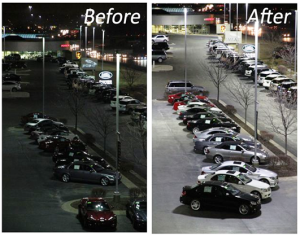“A typical car dealership’s greatest energy expense is lighting. Reducing it can increase a dealership’s profitability while improving the appearance of their products.”
The Energy Alliance Group of Michigan was recently asked to develop a proposal to upgrade and install energy efficient lighting in a prominent Michigan car dealership. The dealership was spending an average of $64,000 annually for lighting repair, electricity and bulb replacement.
The lit areas under consideration for upgrade included the dealership’s service, parts and paint departments plus the new and used car lots. The outdoor lots were lit for an average of 4300 hours per year while the interior lights were lit over 3,200 hours per year.
After completing a detailed audit of the operation, The Energy Alliance Group prepared a proposal that included a 20 year cost analysis. The analysis revealed that energy efficient lights could reduce the dealerships cost of lighting to $27,000 per year from the present $64,000! An annual savings of over $37,000!
The owner of the dealership was stunned by the amount of dollars being wasted with the present outdated light technology. When asked why he had not updated sooner, the owner described three challenges that had prevented him from taking action:
1) Existing Lighting Technology – the outdoor car lots were utilizing light technology that was originally installed when the dealership was constructed in 1973. It was simply easier to continue with the present technology that was already in place. That came with a big expense. Because all of the bulbs had to be replaced on average every six years and took over an hour per bulb to replace, the cost to replace them was over $85 each! When the owner realized how much it was costing him to NOT make a change, updating suddenly made sense.
 Added Benefit –the existing lighting technology in addition to being expensive, created poor quality light. A car’s color was totally different under the lights than how it appeared in sunlight. The Energy Alliance Group chose LED lighting because its life expectancy is three times longer than the current technology, uses 70% less energy, and yet provides superior quality of light. Blue cars look blue whether during the light of the sun or the lights at night.
Added Benefit –the existing lighting technology in addition to being expensive, created poor quality light. A car’s color was totally different under the lights than how it appeared in sunlight. The Energy Alliance Group chose LED lighting because its life expectancy is three times longer than the current technology, uses 70% less energy, and yet provides superior quality of light. Blue cars look blue whether during the light of the sun or the lights at night.
—
2) Perceived Cost – the cost of updating lighting is often considered a big challenge because on the surface it appears to be just another big expense. In reality there are many ways to make updating affordable or cost neutral. Using a variety of utility refunds, tax incentives and financing options, the cost can be very minor, or in many cases generate a positive cash flow. The key is to use every program available in order to minimize any impact to cash flow.
Improved Cash Flow – Using Michigan’s Lean and Green PACE financing program, utility refunds and tax incentives, the proposal achieved a 46% improvement in cash flow from day one due to the resultant energy savings. Simply put, for every $1.00 saved, the dealership only utilized $0.54 of that dollar to pay for their lighting improvements. This resulted in a $16,685 annual cash flow improvement.
3) Lack of Information – converting to energy efficiency is a knowledge intensive process. It’s not as simple as going out and buying the latest technology. It takes an in-depth look at how a facility uses its energy, lighting and what type of environment they need to operate in. There is a long list of factors that determine what is best for an individual business.
Find the Right Solution – The Energy Alliance Group of Michigan guides its clients through the complexities of technology and service choices, utility and tax incentives and project financing alternatives. Our clients expect the greatest energy savings and a maximum return on investment. To meet that expectation, in addition to the lighting proposal, EAG showed the dealership similar savings that could be achieved by upgrading their heating, service bay door technology and compressed air systems. In total the facilities overall electrical usage could be reduced by 56%. To offset the cost of the remaining electrical usage, a 150KW solar system was proposed to further reduce the cost of operation by 80%. All of the proposed changes qualified for utility refunds, tax incentives and financing under Michigan’s Lean and Green PACE financing program.
If you’re concerned about wasted energy EAG has compiled a free report entitled Ten Questions to Ask Before an Energy Efficiency Upgrade! The report details the most important information you should consider for a successful project launch. Want a copy of the report? Just click HERE.
The Energy Alliance Group of Michigan is a leader in clean energy PACE project development and financing.

What does lighting of building and car lot do for the business after business hours? Security? Do the lights call 911 or arest theives or vandals? Do lights help with sales? Most drivers focus their attention on thier lane of traffic not on sidewalks or businesses on the route. You alos have the bad press of bright lights glaring in drivers eyes. In my area a dealershop recently went into bankruptcy partly because their lighting bill annually the retail price of 2 cars.